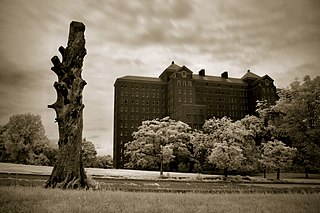
The Kings Park Psychiatric Center, known by Kings Park locals as "The Psych Center", is a former state-run psychiatric hospital located in Kings Park, New York. It operated from 1885 until 1996, when the State of New York closed the facility, releasing its few remaining patients or transferring them to the still-operational Pilgrim Psychiatric Center.

The Danvers State Hospital, also known as the State Lunatic Hospital at Danvers, The Danvers Lunatic Asylum, and The Danvers State Insane Asylum, was a psychiatric hospital located in Danvers, Massachusetts. It was built in 1874, and opened in 1878, under the supervision of prominent Boston architect Nathaniel Jeremiah Bradlee, on an isolated site in rural Massachusetts. It was a multi-acre, self-contained psychiatric hospital designed and built according to the Kirkbride Plan.
Eloise Psychiatric Hospital was a large complex located in Westland, Michigan. It was named after Eloise Dickerson Davock, the daughter of Detroit's postmaster.

Pilgrim Psychiatric Center, formerly known as Pilgrim State Hospital, is a state-run psychiatric hospital located in Brentwood, New York. Nine months after its official opening in 1931, the hospital's patient population was 2,018, as compared with more than 5,000 at the Georgia State Sanitarium in Milledgeville, Ga. At its peak in 1954, Pilgrim State Hospital could claim to be the largest mental hospital in the U.S., with 13,875 patients. Its size has never been exceeded by any other facility, though it is now far smaller than it once was.
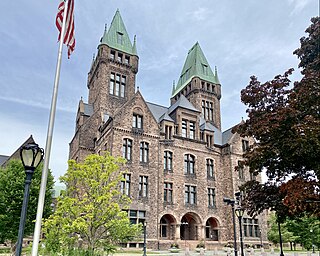
The Richardson Olmsted Campus in Buffalo, New York, United States, was designated a National Historic Landmark in 1986. The site was designed by the American architect Henry Hobson Richardson in concert with the famed landscape team of Frederick Law Olmsted and Calvert Vaux in the late 1800s, incorporating a system of treatment for people with mental illness developed by Dr. Thomas Story Kirkbride known as the Kirkbride Plan. Over the years, as mental health treatment changed and resources were diverted, the buildings and grounds began a slow deterioration. By 1974, the last patients were removed from the historic wards. On June 24th, 1986, the former Buffalo State Asylum for the Insane was added to the National Historic Landmark registry. In 2006, the Richardson Center Corporation was formed to restore the buildings.
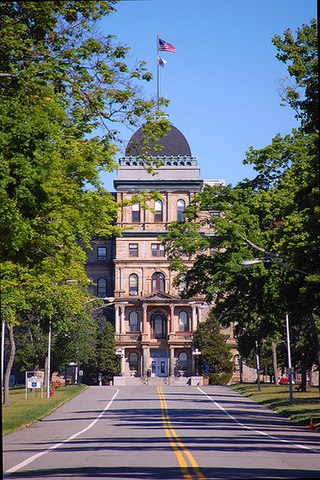
Greystone Park Psychiatric Hospital referred to both the former psychiatric hospital and the historic building that it occupied in Morris Plains, New Jersey. Built in 1876, the facility was built to alleviate overcrowding at the state's only other "lunatic asylum" located in Trenton, New Jersey.
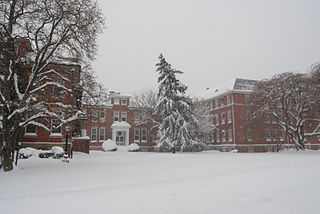
The Crownsville Hospital Center was a psychiatric hospital located in Crownsville, Maryland. It was in operation from 1911 until 2004.

Dixmont State Hospital was a hospital located northwest of Pittsburgh, Pennsylvania. Built in 1862, Dixmont was once a state-of-the-art institution known for its highly self-sufficient and park-like campus, but a decline in funding for state hospitals and changing philosophies in psychiatric care caused the hospital to be closed in 1984. After more than two decades of abandonment, it was demolished in 2006. The campus spanned a total of 407 acres (165 ha). Reed Hall is listed on the National Register of Historic Places.

Peoria State Hospital Historic District, also known as Bartonville State Hospital or Illinois Asylum for the Incurable Insane, was a psychiatric hospital operated by the State of Illinois from 1902 to 1973. The hospital is located in Bartonville, Illinois, near the city of Peoria in Peoria County. The hospital grounds and its 63 buildings are listed as a historic district on the National Register of Historic Places.
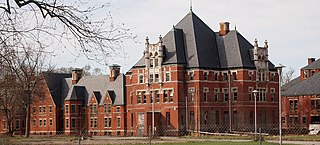
The Norwich State Hospital, originally established as the Norwich State Hospital for the Insane, later shortened to the Norwich Hospital, was a psychiatric hospital located in Preston and Norwich, Connecticut. It opened its doors in October 1904 and operated until October 10, 1996. Throughout the near decade it operated, it housed geriatric patients, chemically dependent patients, and from 1931-1939, tubercular patients. The hospital, which sits on the banks of the Thames River, began with a single building on 100 acres of land, and expanded to over 30 buildings and 900 acres at it's peak. A 70 acre property including the hospital was listed as a historic district on the National Register of Historic Places in 1988.
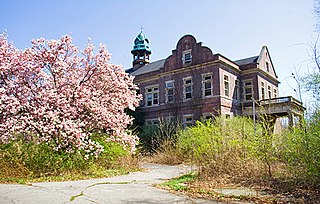
Pennhurst State School and Hospital, originally known as the Eastern Pennsylvania State Institution for the Feeble-Minded and Epileptic was a state-run institution for mentally and physically disabled individuals of Southeastern Pennsylvania located in Spring City. After 79 years of controversy, it closed on December 9, 1987.

The Hudson River State Hospital is a former New York state psychiatric hospital which operated from 1873 until its closure in the early 2000s. The campus is notable for its main building, known as a "Kirkbride," which has been designated a National Historic Landmark due to its exemplary High Victorian Gothic architecture, the first use of that style for an American institutional building. It is located on US 9 on the Poughkeepsie-Hyde Park town line.

The Brattleboro Retreat is a private not-for-profit mental health hospital that provides comprehensive inpatient, partial hospitalization, and outpatient treatment services for children, adolescents, and adults.

The South Carolina State Hospital was a publicly funded state-run psychiatric hospital in Columbia, South Carolina. Founded in 1821 as the South Carolina Lunatic Asylum, it was one of the first public mental hospitals established in the United States. The Mills Building, its first building, was designed by early American architect Robert Mills, and is a National Historic Landmark. The hospital had more than 1,000 patients in 1900, but with the transition of mental health facilities to community settings, it closed in the late 1990s. While buildings on the campus were temporarily used for inpatient services into the early 2000s, they were not part of the State Hospital, but other inpatient facilities of the agency. Several buildings on its campus housed offices and storage facilities of the state's Department of Mental Health until approximately 2014. In October 2014, the Department sold the first parcels of the property into private ownership and received the first sale proceeds. The William S. Hall Psychiatric Institute remained on the campus until 2015, when it moved to a new facility on Department's Northeast Columbia Campus. As of January 2021, 100% of the South Carolina State Hospital property had been transferred to private ownership. Proceeds from the sale of the Bull Street property must be used to benefit patients of the Agency. As of August 2020, the SC Mental Health Commission had authorized the expenditure of $10 million of the proceeds, $6.5 million, for the development of additional community housing for patients.
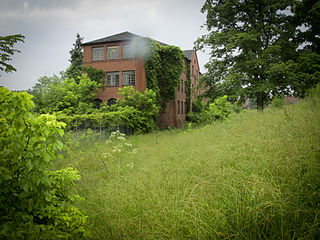
Mayview State Hospital was a psychiatric hospital, originally known as Marshalsea Poor Farm, located in South Fayette Township near Bridgeville, Pennsylvania. It spanned 335 acres (136 ha) and had 39 buildings, 12 of which were used for patient care and hospital administration. It had a staff count of approximately 502 as of August 2007, and an operating budget of $63 million per year. It was demolished in 2016.

Norristown State Hospital, originally known as the State Lunatic Hospital at Norristown, is an active state-funded psychiatric hospital located outside the city of Philadelphia in suburban Norristown, Pennsylvania. It was originally designed between 1878 and 1880, by the local firm of Wilson Brothers & Company; of which, the original structure was set in a red brick Victorian High Gothic motif. It remains active for its originally clinical intention, and currently serving Bucks County, Chester County, Delaware County, Montgomery County and Philadelphia County, providing clinical services in General Psychiatry and Forensic Psychiatry. Additionally, there are various agencies that sublet state hospital buildings for a variety of psychiatric, residential and social services. These agencies currently make up the majority of services that are offered on the grounds of the hospital.
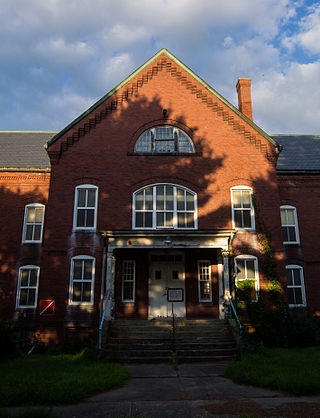
Medfield State Hospital, originally the Medfield Insane Asylum, is a historic former psychiatric hospital complex at 45 Hospital Road in Medfield, Massachusetts, United States. The asylum was established in 1892 as the state's first facility for dealing with chronic mental patients. The college-like campus was designed by William Pitt Wentworth and developed between 1896 and 1914. After an era dominated by asylums built using the Kirkbride Plan, Medfield Insane Asylum was the first asylum built using the new Cottage Plan layout, where instead of holding patients in cells, they would be integrated into a small community and work a specific job. It was formally renamed "Medfield State Hospital" in 1914.
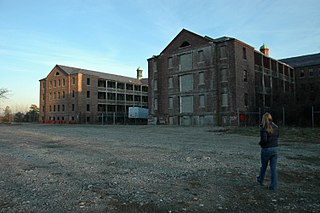
Northampton State Hospital was a historic psychiatric hospital at 1 Prince Street on top of Hospital Hill outside of Northampton, Massachusetts. The hospital building was constructed in 1856. It operated until 1993, and the building was added to the National Register of Historic Places in 1994.

Riverview Hospital was a Canadian mental health facility located in Coquitlam, British Columbia. It operated under the governance of BC Mental Health & Addiction Services until it closed, in July 2012. In December 2015, the provincial government announced plans to replace the obsolete buildings with new mental health facilities, scheduled to open in about 2019. On October 12, 2021, the new Red Fish Healing Centre for Mental Health and Addiction opened on the site.
Marlboro Psychiatric Hospital was a public hospital in Marlboro Township, Monmouth County, New Jersey, United States, which was operated by the State of New Jersey. Construction of the hospital began in 1929. It first opened in early 1931, with Dr. J.B. Gordon as medical director. According to the site plan, the hospital's campus was on 468 acres (189 ha). A perimeter fence completely enclosed the property. The land was mostly a rural environment. When it closed, the hospital was on 594 acres (240 ha), having enlarged the grounds over the years. It opened with a capacity to accommodate 500-800 patients. The grounds construction continued after opening and when completed, the hospital was expected to have a capacity of 2,000 patients. However, in 1995, the hospital served an average of 780 adults per day with a staff of 1,157 employees and a total budget of $55.5 million. The budget in 1998 was $68 million. The facility was closed July 1, 1998. The hospital finished complete demolition of the structures, tunnels, roads and other infrastructure in early 2015.



















